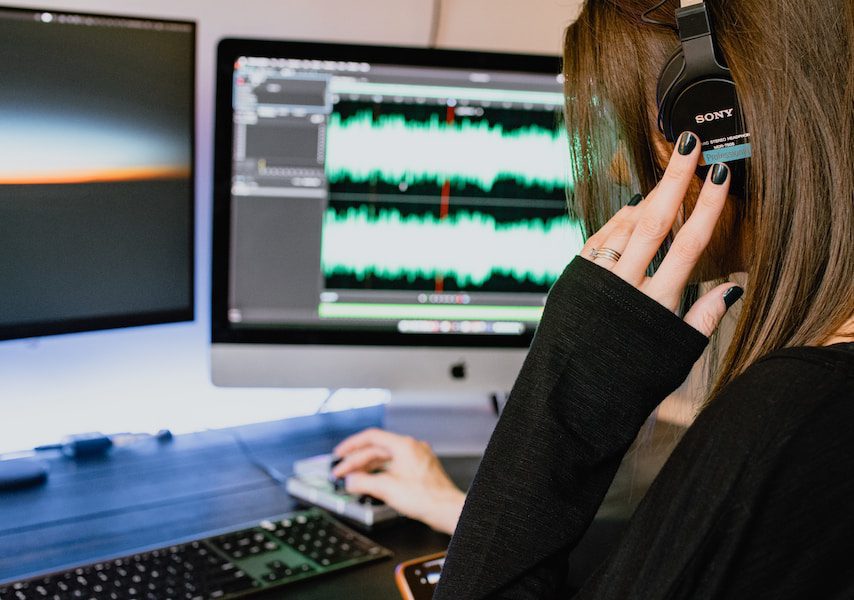Audio clipping is a term used in the audio industry to describe a distortion that occurs when an audio signal exceeds the maximum level a system can handle. When an audio signal is amplified beyond its maximum level, the waveform is clipped, resulting in sound distortion.
Audio clipping is a distortion that occurs when an audio signal is amplified beyond the maximum level the audio system can accurately reproduce. This results in a distorted waveform cut off at the maximum level, creating a flat, clipped top and bottom of the waveform. This distortion can be heard as a harsh, crackling, unpleasant sound.
While clipping can sometimes be used creatively in music production, such as in certain electronic music genres, it is generally considered undesirable in most contexts. To avoid clipping, it is important to properly set levels and gain stages throughout the entire audio signal chain and to use equipment that can handle the dynamic range of the audio being recorded or played back.
Table of Contents

What is Audio Clipping?
Clipping is often heard as a harsh, distorted sound and can be particularly noticeable in high-frequency sounds such as cymbals or sibilant vocals. Clipping can occur at any stage of the audio signal chain, from recording to playback. It can be caused by several factors, including improper gain staging, overloading of equipment, or a poorly designed audio system.
Definition
Audio clipping occurs when the amplitude of an audio signal exceeds the maximum level that the audio system can accurately reproduce. This can happen at any stage in the audio signal chain, from the microphone to the speakers. Clipping can occur in analog and digital audio systems, although the causes and effects can differ.
Causes
Audio clipping can be caused by a variety of factors, including:
- Overdriving a microphone or preamp
- Using a low-quality audio interface or amplifier
- Recording at too high a level
- Using too much gain or compression
In digital audio systems, clipping can also occur when the signal is converted from analog to digital and back again. This can happen if the signal exceeds the maximum level represented by the digital system, resulting in a clipped waveform.
Effects
The effects of audio clipping can be heard as a harsh, crackling distortion that can be unpleasant to listen to. Clipping can also cause the loss of detail and dynamic range in the audio signal, resulting in a compressed and flattened sound. In extreme cases, clipping can also cause damage to speakers and other audio equipment.
Preventing Audio Clipping
Audio clipping can be a frustrating problem for sound engineers and music producers. Fortunately, several techniques can be used to prevent audio clipping and ensure that your recordings sound clean and professional. Here are some methods to consider:
Gain Staging
One of the most critical steps in preventing audio clipping is gain staging. This involves setting the levels of each component in your audio chain to ensure that the signal remains at an appropriate level throughout the recording process.
By carefully managing the levels of each component, you can prevent audio clipping and ensure that your recordings sound clear and balanced. If the signal is too low, you may need to boost it with a preamp or gain control. If the signal is too high, you may need to attenuate it with a pad or gain reduction.
Compressors and Limiters
Another effective way to prevent audio clipping is to use compressors and limiters. These devices are designed to automatically reduce the audio signal level when it exceeds a certain threshold. This can help to prevent sudden spikes in volume that can cause clipping.
Compressors and limiters can be used in various ways, depending on the specific needs of your recording. For example, you may use a compressor to smooth out the dynamics of a vocal track or a limiter to prevent a bass guitar from overpowering the mix.
Dithering
Dithering is a technique that reduces distortion when converting digital audio from one particular bit depth to another. When audio is recorded at a high bit depth, it contains a lot of detail and nuance. However, some of that detail is lost when it is converted to a lower bit depth. Dithering helps to minimize this loss by adding a small amount of noise to the signal. This noise helps mask the distortion during the conversion process, resulting in a cleaner, more accurate sound.
A Last Word on Audio Clipping
Audio clipping is a common problem that can occur in any audio recording. It happens when the audio signal exceeds the maximum level the recording device or software can handle. When this happens, the waveform of the audio signal is cut off, resulting in distortion and other unwanted effects.
There are several ways to prevent or minimize audio clipping. One way is to adjust the gain or volume levels of the recording device or software to ensure that the audio signal does not exceed the maximum. Another way is to use a limiter or compressor to control the audio signal’s dynamic range.
To produce high-quality audio recordings, it is essential to understand the causes and effects of audio clipping and how to prevent or minimize it. By following best practices and using appropriate tools and techniques, audio professionals can ensure their recordings are free from clipping and other unwanted artifacts.
- Review of the ALABS IRON MINI-WL: A Powerhouse Wireless Microphone - October 4, 2023
- What is a Saturator in Music Production: A Brief Explanation - May 11, 2023
- What Are Rotary DJ Mixers? An Overview - May 11, 2023
SoundStudiomagic.com is a participant in the Amazon Services LLC Associates Program, an affiliate advertising program designed to provide a means for sites to earn advertising fees by advertising and linking to Amazon.com. We also participate in other affiliate programs which compensate us for referring traffic.

